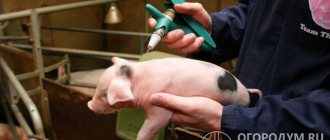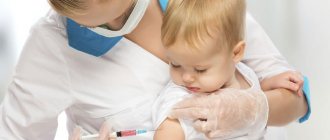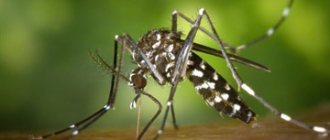On pig farms, piglets must be vaccinated from a very early age to prevent various diseases. Vaccination will help raise healthy and strong animals. This procedure will significantly strengthen the immune system of young individuals. If these principles and norms are ignored, farm owners will suffer considerable losses from constant diseases in pigs. In this article we will look at what types of vaccines babies need immediately after birth.
Compulsory vaccination of newborns
In the case of industrial cultivation, farm owners need to take care of mandatory vaccination of newborns. Owners do many of the required vaccinations for piglets from birth on their own or seek the help of doctors. Before you start vaccinating young animals, you need to carefully study all the features of each of the breeds contained in the pig farm.
Vaccination of animals can be carried out either independently or by signing an agreement with a specialized veterinary institution, where young animals are vaccinated by a doctor. Next, we will look at what vaccinations are given to piglets and at what age. The vaccination schedule depends on the current situation in your area. The veterinarian will advise you on how to properly organize the necessary sanitation in a production environment. Thus, it will be much easier for the farmer to understand the issue of immunization of pigs.

Animal vaccination scheme
It is necessary to vaccinate animals to ensure the normal condition of their body and stable growth. Therefore, piglets are vaccinated from birth. This allows you to prevent the occurrence and stop the development of various dangerous diseases.
Newborn piglets must be vaccinated against iron deficiency anemia, erysipelas, worms, rickets, salmonellosis, plague, streptococcosis, colibacillosis, pasteurellosis, as well as other types of infectious and viral diseases. Young individuals tolerate this vaccination quite easily.
For farmers, we offer a table of vaccinations for piglets from birth at home, recommended by leading experts in the field of veterinary medicine:

For convenient use of the table, the list of vaccinations is placed in chronological order, and vaccines are used as the animals grow older. This immunization plan is designed for implementation on a commercial farm.
What vaccinations do piglets need?
Of course, the most correct decision is to conclude an agreement with a state or departmental veterinary service. Experts will develop a vaccination scheme depending on the situation in your region and give practical advice on organizing veterinary sanitation at work. Nevertheless, every farmer will make his life much easier if he understands the issues of vaccinations in piglets.
So, how is piglets vaccinated at home? First you need to decide what diseases you need to protect your livestock from.
On a farm or private farm, it is mandatory to vaccinate animals against erysipelas and classical swine fever.
Depending on the disease situation in a particular region, a veterinarian may recommend vaccination of piglets against the following infections:
- leptospirosis;
- enterococcosis;
- Aujeszky's disease;
- pasteurellosis;
- salmonellosis.
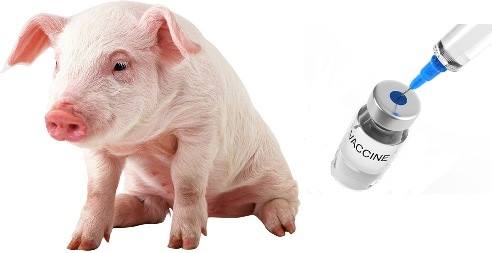
Vaccination schedules will differ between small farms and large pig farms. A busy program of veterinary activities in a private backyard is not needed. But the higher the number of livestock, the more preventive vaccinations the piglets will need.
What other additional injections do piglets need?
In addition to vaccines, piglets are also given other veterinary medications, which in everyday life are also often called vaccinations, which is incorrect. But we will also look at them in this article, since these injections form an important part of the preventive regimen and are often used in combination.
What other injections are given when raising piglets?
- Iron supplements are administered.
- Serums - they are injected both for the prevention and treatment of diseases.
- Medicines against worms.
- Vitamin complexes. They can be given orally from a syringe without a needle or injected intramuscularly. In the latter case, it is better to use water-soluble forms.
Often, the administration of vaccines and other drugs is combined with zootechnical manipulations (castration, marking, canine trimming, weighing, weaning).
Rules for the use of vaccines
After birth, the piglets’ bodies must become stronger so that they can be given an injection. Before vaccination, animals must undergo deworming. Vaccination of newborns begins no earlier than 3 days after birth. Weak and sick animals are not immunized.
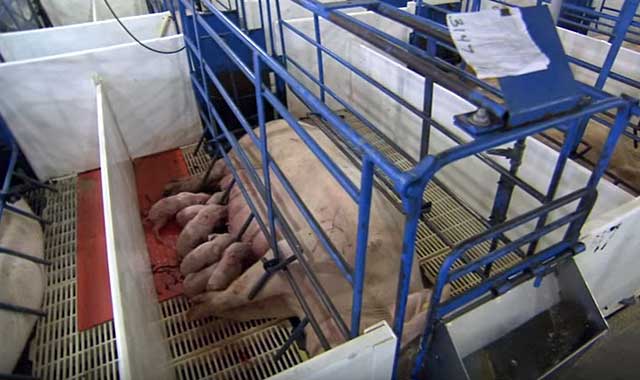
Before using animal vaccinations, pig farm owners must adhere to the following rules:
- vaccinate completely healthy pigs (if piglets are sick, they should be treated with serum and antibiotics);
- Vaccines for pigs should only be stored in cool places;
- strictly follow the dose indicated in the instructions for the vaccine;
- select the right place on the animal’s body for vaccination.
Regarding the last point, for example, if the recommendations indicate that the vaccine should be administered under the skin, then such an injection cannot be given intramuscularly.
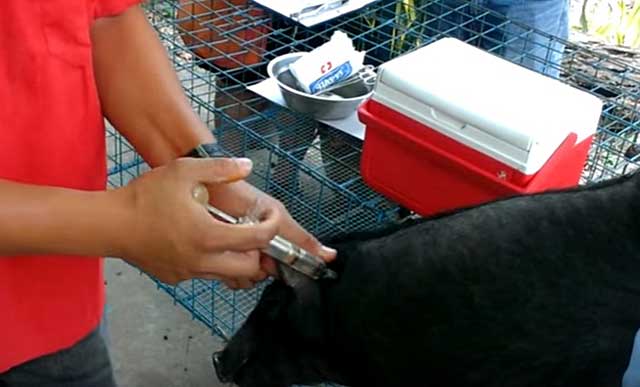
Piglet vaccination schedule
How to build the correct vaccination schedule? To do this, first of all, you need to consult a veterinarian! Here is an approximate schedule of vaccinations and additional medications for piglets from birth, which is built taking into account minimal veterinary treatments:
- at 3 days - injection of iron supplements;
- at 2 months - vaccination against erysipelas;
- at 3 months - vaccination against swine fever.
This scheme can be taken as a basis in prosperous farms with a small number of livestock and good living conditions.
If there is a high concentration of piglets on the farm, the vaccination schedule will be busier. Here is an example of such a diagram:
- 1–2 days after birth - administration of iron-containing drugs;
- 20–30 days - vaccination against salmonellosis, pasteurellosis, enterococcosis - use the PPD or SPS vaccines, twice;
- 45 days - vaccination against classical plague;
- 60–70 days - vaccination against pig erysipelas;
- 72–84 days - revaccination against erysipelas;
- 80–100 days - revaccination against salmonellosis, pasteurellosis and enterococcosis;
- 100–115 days - revaccination against erysipelas.
The development of a vaccination schedule is also influenced by the breed characteristics of pigs. For example, if a farm raises Vietnamese piglets, what vaccinations do they need? — when the disease situation on the farm is favorable and the sow’s milk is of good quality, then the schedule may be as follows:
- vaccination against salmonellosis with a bivalent vaccine, three times - at 40, 35 and 105 days from birth;
- triple vaccination against swine erysipelas - at 75, 100 and 240 days;
- double injection against worms with the antiparasitic drug “Ivermek” - on days 55 and 90.
As for vaccine doses, they are the same for all breeds of pigs and depend only on the type of drug and the age of the piglets being vaccinated. These data are specified in the instructions for each specific medicine.
You also need to take into account that when purchasing piglets, the seller must have a veterinary certificate indicating the vaccinations given. If it is not there, then we proceed from the assumption that vaccination was not carried out. In this case, the piglets are first given anthelmintics, and then given vaccinations accepted on the farm.
Important! After purchasing new livestock, quarantine for one month.
Now let's talk in more detail about vaccinations against the main infections of piglets, as well as other injections that are given to them.
To save yourself from anemia
Vaccination with a solution that contains iron is one of the first things to be done after the piglet is born. In pig farms, the injection is performed on the 4th day after birth. Farmers administer the vaccine to animals themselves, taking into account the recommendations of experienced doctors. This procedure is performed to prevent iron deficiency anemia.
Most often, 2 ml of Ferranimal is used per newborn. The vaccine must be injected behind the ear every day. Animals are vaccinated over 3 days at the same time of day.
To treat iron deficiency anemia, together with vaccination, small animals should be given 1.5 g of copper sulfate and 15 g of ferrous sulfate solution in their daily diet. The substances used should be diluted in 1 liter of water and given to animals 5 ml every day, and adult pigs should be given a solution from a trough.
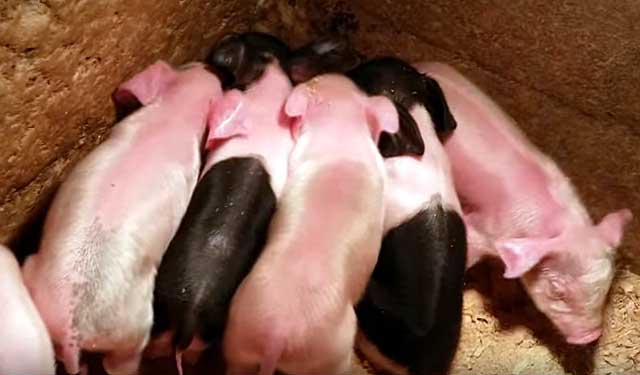
Vaccination against salmonellosis
Salmonellosis is a bacterial infection that affects both humans and animals, manifested by high body temperature, diarrhea and pneumonia. Piglets often get sick when kept in unfavorable conditions (overcrowding, cold, dampness).
Vaccination against salmonellosis must be done in large pig farms and on disadvantaged farms. To prevent the disease, a live bivalent vaccine from the attenuated strains “Salmonella typhimurium No. 3” and “Salmonella cholerasuis No. 9” is used.
Piglets are vaccinated against salmonellosis three times:
- on day 25;
- at 35;
- and on the 90th day.
Or the dates can be shifted - to 46, 56 and 116 days.
Piglets should not be given antibiotics for three days before vaccination and seven days after it.
Vaccinating animals against plague
The most common and deadly disease is plague. This infection is caused by a virus that can infect up to 95% of unvaccinated piglets. It poses a great danger to pigs and wild boars. Death can be prevented through vaccination. Vaccination of young animals is carried out after 40 days, and after 90-100 days of life, revaccination is done. This procedure must be performed annually.
One of the following drugs is used for vaccination:
- VGNKI virus vaccine;
- "KS";
- "ABC";
- Virus vaccine LK-VNIIVViM.
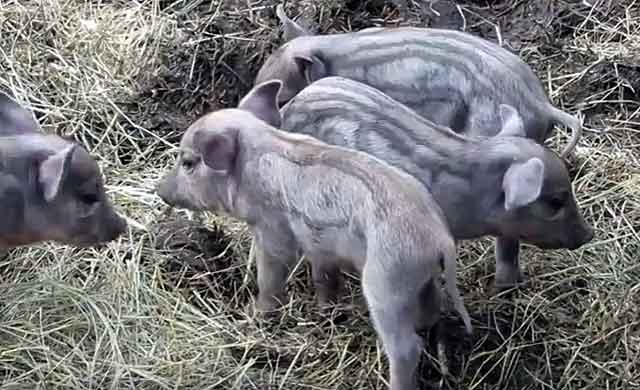
For piglets, use 2 ml of a solution of non-concentrated vaccine "KS". The animal must be injected intramuscularly into the inner thigh or lower third of the neck. To immunize young animals in pig farming, the dry avirulent lipinized vaccine “ABC” is used.
In case of an outbreak of infection, it is necessary to additionally vaccinate each pig with a concentrated solution of “KS”, not taking into account the previous vaccination.
Complex vaccination of piglets
On large farms or in unfavorable conditions in the region, it makes sense to use complex vaccines against several diseases at once. These are inactivated biological products that provide immunity 10–12 days after the second vaccination. Protection against vaccinated diseases lasts for about six months in piglets.
The following drugs are used.
- Vaccine "PPD" against three diseases - against salmonellosis, pasteurellosis and enterococcal infection of piglets (produced by the Armavir biofactory). They inject it into the muscles of the inner thigh. Piglets are vaccinated 3 times: at the age of 20–30 days; in another 5–7 days; and 7–10 days before weaning.
- Vaccine "VERRES-SPS" against salmonellosis, pasteurellosis and streptococcosis. Piglets from unvaccinated sows are vaccinated at the age of 12–15 days. Then, repeat after 8–10 days. Livestock from vaccinated queens are vaccinated at 25–28 days and 33–38 days, and revaccination is done at 90–100 days.
- Vaccine "PPS" against salmonellosis, pasteurellosis and streptococcosis.
- Vaccine "Serdosan" (Ukraine) against five infections: colibacillosis, edema disease, pasteurellosis, salmonellosis and anaerobic enterotoxemia of pigs. The first vaccination is given depending on the situation on the farm, then at intervals of two weeks. Revaccination after 6 months once. The dose of vaccination depends on the age of the piglets.
Enterococcosis (streptococcosis) is vaccinated in disadvantaged farms. To do this, use the SPS vaccine intramuscularly twice:
- 20–30 days 2 ml;
- after 7–10 days, another 2 ml.
Revaccination is carried out after 60–70 days, 4 ml.
Vaccination against pasteurellosis in piglets is also done only in disadvantaged farms. The PPD vaccine is used for piglets according to the general scheme.
Preventive measures against worms and pseudorabies
Vaccination of pigs against worms is mandatory. Parasites can cause a number of dangerous diseases in animals. They disrupt the functioning of the gastrointestinal tract and interfere with normal weight gain in piglets.
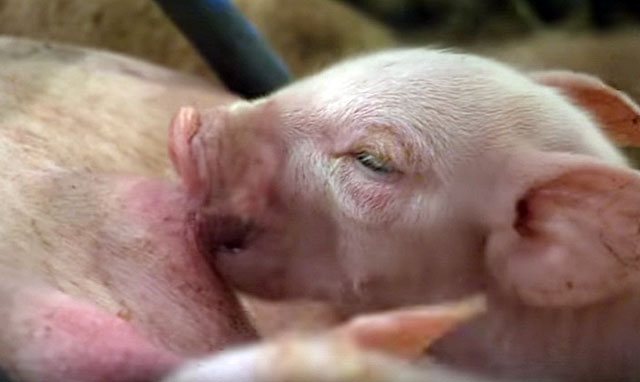
Animals are vaccinated 8 days after birth. Today, many antihelminthic drugs are sold. Before purchasing the product, be sure to consult your veterinarian.
Foreign medicines “Dectomax” and “Panacur” are especially popular among farmers. The administration of drugs is carried out in strict compliance with the instructions. For highly effective deworming, it is better to use one product. After 2.5 months, this procedure should be repeated.
Aujeszky's disease (pseudorabies) often ends in the death of piglets, so 16-30 days after birth they need to be given a cultural vaccine.
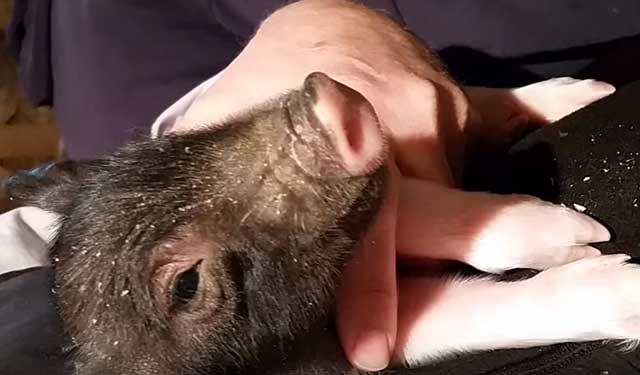
Before three weeks of age, the drug is administered subcutaneously, and after 21 days - intramuscularly. The next vaccination is done 3-4 weeks later, and the third – 140 days after birth.
Vaccination against erysipelas
This disease occurs quite often in piglets. The contagious disease causes severe pain to animals and can affect their skin. A latent infection can become open at any time. The virus of this disease is often spread by flies. To prevent an outbreak of the disease, a dry vaccine from the erysipelas strain BP-2 is used.
The first vaccination is performed 60 days after birth and 1 ml of vaccine is administered via intramuscular injection. The immune preparation is used again after 30 days. The same preventive measures should be taken when animals reach eight months of age.
During an outbreak of the disease, piglets must first be isolated and then undergo forced vaccination, without taking into account the timing of previous vaccination.
After using the drug, animals may experience a sharp rise in temperature, as well as lethargy and decreased appetite. In this case, no treatment is required, and all symptoms will go away on their own.
How to give an injection to a pig?
At home, it is important not to be afraid and confidently give an injection. The main thing is to determine the exact location for the injection. Injections can be given intramuscularly, subcutaneously and intravenously.
For inexperienced breeders, it is optimal to prick intramuscularly and subcutaneously due to the simpler technique. The inner thigh, well-developed muscles and subcutaneous fatty tissue, thin skin are well suited. Injections are given in the area behind the ear only to newborn piglets.
Subcutaneous administration. They grab a small area of skin and pull it back, creating a kind of triangle into which the needle is inserted. In this case, the passage of the needle is almost completely painless and does not cause severe discomfort to the cubs. However, it is important to follow the sequence of actions so as not to harm the baby.
Injection for rickets
On the 10th day of age, piglets are given a vaccine for preventive measures against rickets. This drug contains calcium and sodium components. In addition to vaccinations, children can add fish oil, shellfish, limestone and chalk to their daily diet. They are mixed into the animals' food or introduced into the mouth using a spoon or syringe without a needle.
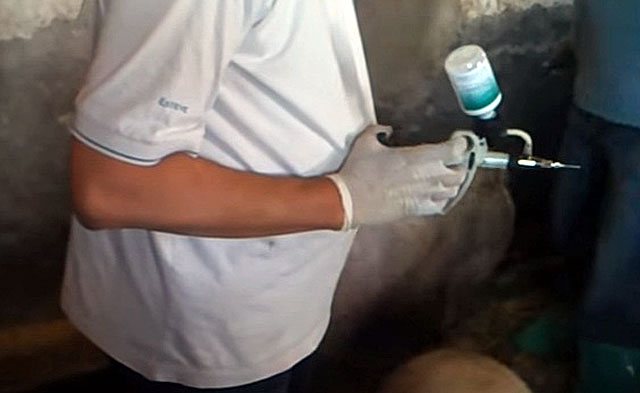
In addition to preventive measures against rickets, special mercury-quartz lamps are used. These devices are designed to destroy a variety of viral infections on the piglet or in its environment.
This quartz treatment is used upon reaching ten days of age. For a full course you need to carry out 7 procedures; to get a good effect you need to do it every other day. As a comprehensive measure, vitamin preparations can also be added to the animals’ diet.
Prevention of colibacillosis
Colibacillosis is an acute disease from which pigs often die. For preventive measures, polyvalent serum is used. This substance is administered to animals in an amount of 9-10 ml 5 days after birth, and 10-15 ml is administered to piglets older than five days of age.
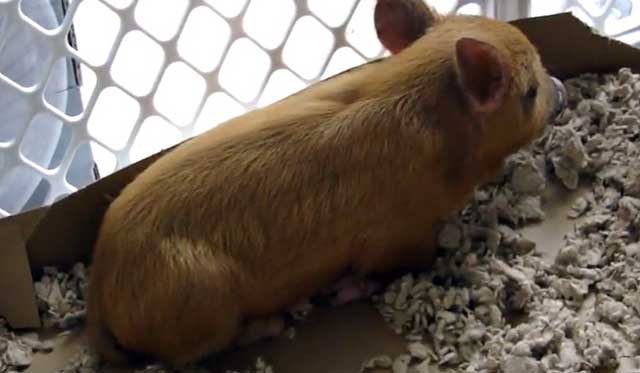
As an antiparasitic agent, after 2 and 3 months from birth, young animals need to be injected with Ivermek, a drug that has low toxicity and excellent therapeutic efficacy at a small dosage. Piglets are given an injection in the cervical region, independently calculating the required dosage (1 ml of product per 33 kg). Read more in the article “Using Ivermek for pigs.”
After 50, 57 and 60 days, experts recommend injecting young pigs with PDE - a tissue preparation made from human placenta and which can significantly increase the safety of piglets. This substance is used for preventive measures against diseases of the gastrointestinal tract.
Deworming of piglets before vaccination
Even before vaccinations, piglets need to be prevented from worms. For the first time, they must be dewormed immediately after purchase, and only then can the livestock be vaccinated.
Safe piglets from a reputable supplier (or from a treated sow) are dewormed at 2–4 months of age. Fast-growing piglets on large farms are treated at 55 and 90 days.
Broad-spectrum anthelmintics are used to vaccinate piglets against worms. New generation drugs are administered once:
- "Levamisole" 7.5% intramuscularly at a dose of 1 ml per 10 kg of body weight;
- “Tetramizole” is granulated 10% with food 75 g per 10 kg of body weight, and given in the morning after fasting;
- "Ivermek" intramuscularly at a dose of 1 ml per 33 kg of body weight;
- "Univerm" with food at the rate of 5 g per 100 kg of body weight, also with a morning portion of food.
Anthelmintics should not be used on piglets for one week before vaccination and two weeks after it.
Vaccination against foot and mouth disease and encephalitis
For prevention, after piglets reach two months of age, they can be vaccinated against foot and mouth disease. Owners of pig farms must first consult with a doctor about this procedure, since the vaccine is not included in the mandatory vaccination plan.
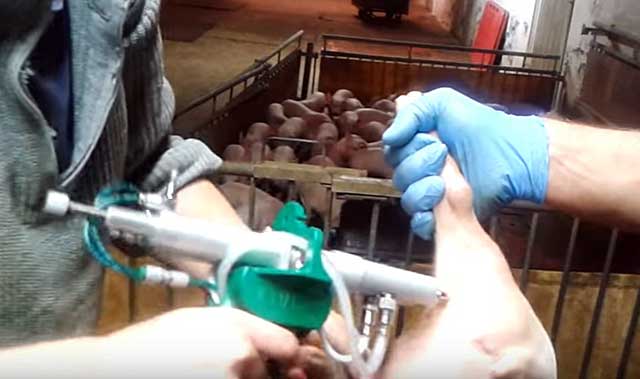
The drug “Immunolactan” is used for injection. Animals less than 3 months old need 0.4 mg, and older pigs need a dose of 0.1 mg per 1 kg of body weight. Piglets get foot and mouth disease quite rarely, but when infected they often die.
2 months after birth, young animals need to be injected with a vaccine against encephalitis. This injection is not included in the general vaccination scheme, so farmers themselves decide whether there is a need for an injection. To achieve an effective result from the vaccine, it should be used once. Animals aged from 30 days to 3 years can get encephalitis.
Vaccination against erysipelas of pigs
Erysipelas is a common bacterial disease that infects domestic and wild animals, as well as humans. A special feature of the infection is its stationary nature. The incidence does not exceed 20–30%, which is associated with natural resistance or latent transmission of the disease earlier. Lactating piglets are protected by antibodies transmitted through mother's milk.
pig mug
However, swine erysipelas causes great economic damage to farms. Some of the sick animals die, and treating the disease requires money. Another point is that the pathogen may remain in the pigs’ body for a long time without showing itself in any way. But as housing and feeding conditions worsen, immunity weakens and an outbreak of erysipelas occurs in the herd without the introduction of infection from outside. Therefore, the only correct solution is the universal vaccination of pigs both in large pig farms and in private farmsteads.
Piglets are vaccinated against swine erysipelas with one of the domestically produced vaccines.
- “Deposited vaccine against swine erysipelas” (liquid). The first injection is given at the age of 2 months, and repeated two weeks later. Revaccination is done another month later.
- “Vaccine against swine erysipelas from strain BP-2.”
The vaccination schedule with the latest drug is as follows:
- on day 60;
- on days 85–90;
- at 240.
Or at 74, 104 and 260 days.
Adult animals require booster vaccination every 5 months. Piglets are excluded from antibiotics for 7 days before and after the procedure. Vaccination against swine erysipelas can be combined with the administration of most vaccines.
Prevention of salmonellosis development
Vaccination of piglets against salmonella is of particular importance, because the causative agent of the disease provokes serious consequences for animals. This disease is most often diagnosed in small animals, which are especially susceptible to infection in winter.
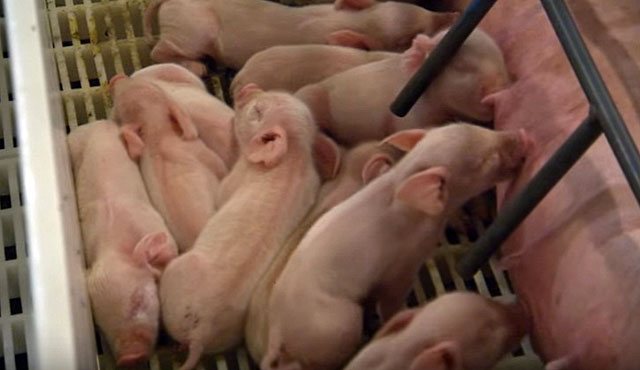
Due to the high degree of contagiousness, salmonellosis quickly acquires an acute form of development and leads to various pathologies of the piglet’s digestive and respiratory systems.
Piglets are vaccinated against salmonella 3 weeks after birth. The vaccination used for piglets can also prevent the occurrence of streptococcosis and pasteurellosis. The vaccine against these diseases consists of two potent substances.
The first of them - PPD - is given to animals in the amount of 4 g per individual, and after 7 days the vaccination is repeated in the same dosage. The second substance - SPS - is administered intramuscularly for one week at the rate of 2 ml per piglet. After a month, the injection is given in the amount of 4 ml of solution.
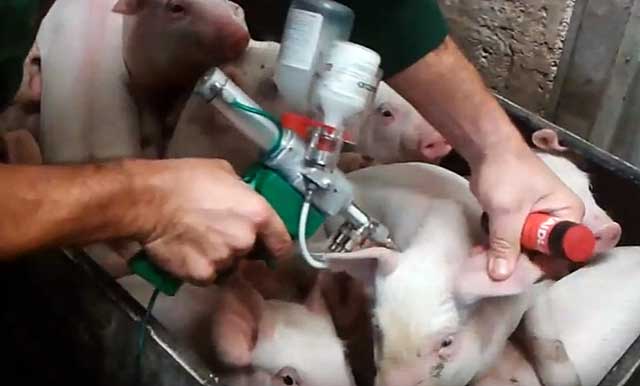
What vitamins are there for pigs?
Vitamin A
He is responsible for the quality growth of the pig. Vitamin A is also necessary for the body for reproductive function and good vision. Vision problems greatly affect the general condition of the pig, especially if we are talking about a growing piglet. If an animal sees poorly, then it eats less, which contributes to slower growth. Also, these problems affect the functioning of the digestive and respiratory systems, which causes various diseases.
A lack of vitamin A is very dangerous for the sow - they give birth less often, the number of cubs in one farrow becomes smaller, the viability and size of one fetus is significantly reduced. With a prolonged shortage of this substance among pregnant mothers, the risk of abortion, the birth of stillborn piglets and cubs with defects increases.
A lack of vitamin A in boars leads to a deterioration in the quality of seminal fluid and its fertilizing ability. Therefore, it is important to monitor the presence of this vitamin in the pig’s diet year-round.
Feeds that contain it:
- green grass;
- carrot;
- flour from grass and pine needles;
- fish fat;
- sprouted grain;
- pumpkin crops;
- yellow corn.
Vitamin D
Vitamin D for pigs is necessary for the proper development of their skeletal system. This component is capable of being synthesized by the piglet’s body under the influence of ultraviolet rays. Therefore, in order for its bones to be strong and strong, the room where the animal lives must be dry, with good lighting and ventilation.
You also need to ensure the correct balance of minerals and protein. With a lack of vitamin D, pigs develop rickets, limbs and joints change, and growth slows down. Reproductive functions in sows decrease, which affects the number of offspring and their health and leads to postpartum complications.
Preventive measures that protect piglets from rickets include fresh air, being outside and on pasture in the summer, irradiation with ultraviolet lamps in the winter.
So, the pig’s body is able to produce this vitamin on its own, but for this the animal must be in the sun.
The following foods are also sources of vitamin D for pigs:
- fish fat;
- whole milk;
- multivitamins.
Vitamin E
If the level of vitamin E in pigs is normal, then their tissues are protected from degeneration and subsequent necrosis. If there is a deficiency of this vitamin, spots of varying sizes begin to form on the animal’s skin.
Also, E-vitaminosis negatively affects the reproductive functions of the sow, leading to increased incidence of intrauterine mortality, infertility, the birth of weak, sickly offspring, and loss of milk. A sufficient amount of this vitamin will ensure milk production and fertility in female pigs, and will also help absorb vitamin A and carotene.
Main foods containing vitamin E:
- green mass of legumes;
- ensilage;
- grass meal;
- barley;
- yellow corn;
- oats;
- wheat.
Vitamin B
The most important vitamin for the pig’s reproductive system is vitamin B. A lack of it in the female’s body leads to miscarriages, the birth of premature babies, low birth rates, and the birth of sick piglets.
A lack of vitamin B for a piglet entails serious consequences - growth slows down, problems with the functioning of the cardiovascular system arise, diarrhea and vomiting appear. Vitamin B deficiency leads to increased mortality among piglets and health problems in the offspring.
A lack of vitamins B3 and B5 provokes a violation of amino acid metabolism, a decrease in protein production and immunity, loss of appetite and a decrease in growth rate, the appearance of seizures and “goose steps”.
Foods containing vitamin B:
- green feed;
- bran;
- roots;
- cereals;
- cakes of grain and legumes;
- grass meal;
- milk.

